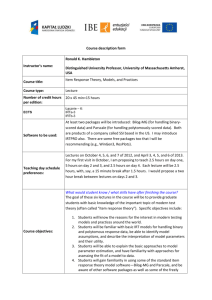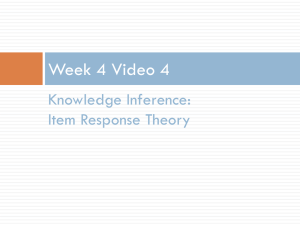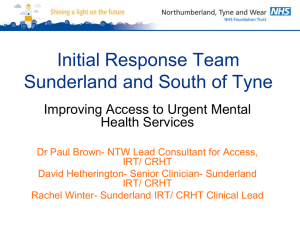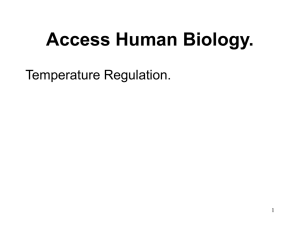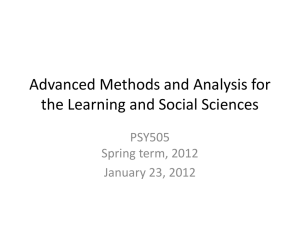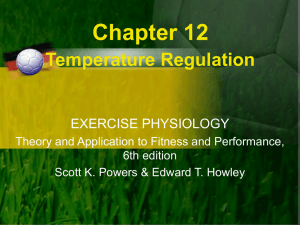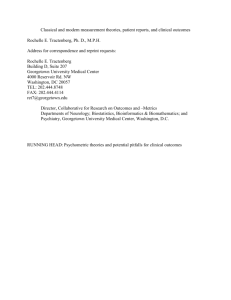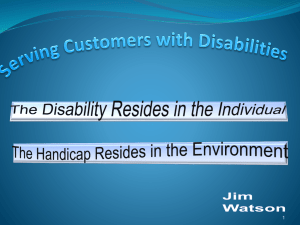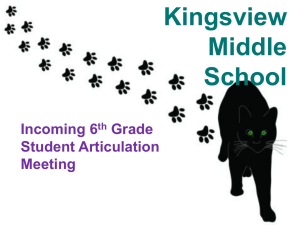IRT
advertisement
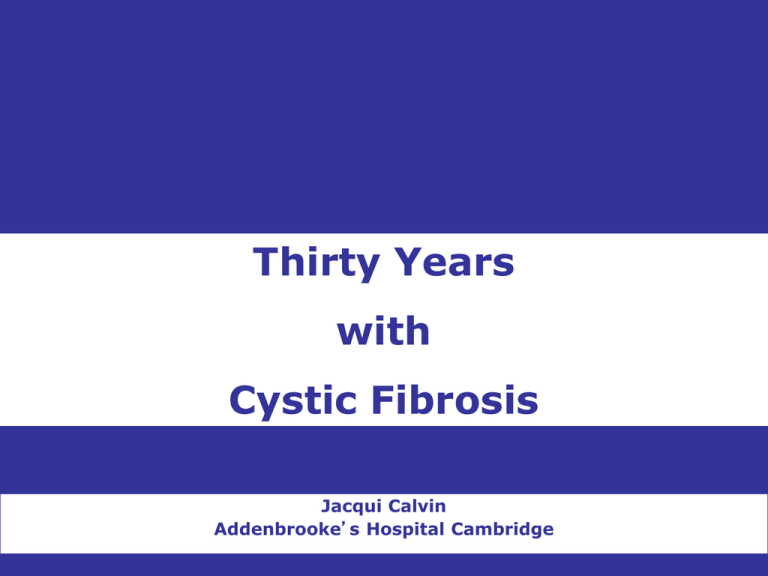
Thirty Years with Cystic Fibrosis Jacqui Calvin Addenbrooke’s Hospital Cambridge Screening area – Norfolk, Suffolk, Cambridgeshire Screening for CF since 1979 First year a pilot to set cut-offs Routine screening - January 1980 Various assays and protocols used First CF patient detected on screening First CF child detected by IRT screening – October 1980 Reported in ‘Current issues in neonatal screening for cystic fibrosis and implications of the CF gene discovery’. Farrell et al 1991 Ped Pulmonol We have two earlier CFs – dob June/July 1980 Protocols Jan 1980 – April 2004 IRT–IRT protocol Based on prolonged hypertrypsinaemia seen in the majority of babies with CF May 2004 onwards IRT-DNA-IRT p.Phe508del followed by 29 panel Jan 09 changed to 4 mutation panel CFTR Total babies screened Jan 1980 to December 2009 730,730 Give or take a few! What are we measuring? Trypsinogen-1 (encoded by PRSS1 gene) cationic Trypsinogen-2 (encoded by PRSS2 gene) anionic In health cationic > anionic Pancreatitis anionic >> cationic 19 CF blood spots anionic:cationic ratio = 0.49-3.5 15/19 anionic > cationic (Lindau-Shepard and Pass 2010) Trypsin(ogen) in blood a1-antitrypsin Cationic trypsinogen a1-AAT Binds 15% trypsin a2-macroglobulin a2-macroglobulin trypsin Binds 85% trypsin Anionic trypsinogen Dhondt & Farriaux 1994 Behring RIA kit Samples from CF babies showed a bimodal decay curve suggesting a different mix of IRT species Sorin Radioimmunoassay Polyclonal antibodies raised to inactivated cationic trypsin Cross reactivity: trypsinogen - 98% a1AT bound trypsin 15% a2macroglobulin bound trypsin 1% AGEN Two monoclonal antibodies raised to cationic trypsinogen Enzyme immunoassay ?cross reactivity with other species Delfia/autodelfia Dissociation-Enhanced Lanthanide Fluorescent Immunoassay Monoclonals raised to ???? Antibodies chosen gave the best discrimination between normal and CF bloodspots Time period Kit Protocol 1st action limit 2nd action limit IRT mg/L IRT mg/L Jan 80 – March 90 Sorin IRT-IRT 60 50 April 90 – Sept 92 Agen IRT-IRT 35 35 Oct 92 – March 01 Delfia IRT-IRT 70 60 April 01 – April 04 Autodelfia IRT-IRT 70 60 May 04 – Dec 09 Autodelfia IRT-DNA-IRT 70 60 1st samples collected day 6-10 (Jan 1980 to March 2000), day 5 - 8 (April 2000 onwards) Definitions Protocol intended to maximise diagnosis of CFTR defects producing preventable/treatable disease in infancy or childhood. To minimise diagnosis of very mild forms of CFTR defects producing late-onset, essentially unpreventable disease. False negative: A ‘not suspected’ result in a child presenting before the age of 16 years with signs and symptoms of CF, subsequently diagnosed clinically False positive: A ‘suspected’ result in a child not diagnosed with CF Numbers screened and false positives Protocol IRT-IRT IRT-IRT IRT-IRT IRT-IRT IRT-DNA-IRT Kit Sorin Agen Delfia Autodelfia Autodelfia Total 234, 098 65,222 210,356 73,290 147,764 n 24 22 37 13 9 FP % 0.01 0.03 0.02 0.02 0.006 Babies with CF Total number known to screening lab: 325 Positive screen: 296 Includes 53 with meconium ileus 13 sibs or diagnosed prior to screening 29 ‘Not suspected’ Including 10 meconium ileus Meconium ileus 53 cases of MI 9 ‘Not suspected’ 1 ‘Probable carrier’ Well known that MI causes problems – up to 25% have negative screening results Traditionally excluded from screening stats False positives: IRT-IRT protocol Clinical details n Term, well babies 43 Multi-organ failure and/or sepsis Birth trauma, hypoxia Extreme prematurity 31 6 1 Gastroschisis Pyloric stenosis Ileal atresia 3 1 1 Renal disease Liver disease 3 2 Trisomy 13 Trisomy 18 2 2 Galactosaemia (symptomatic) 6 GALACTOSAEMIA 17/21 galactosaemics had raised IRT at time of diagnosis (Anthony & Mary Heeley and Karen Poyser) IRT concentrations in untreated galactosaemia are comparable to those seen in CF IRT pre and post treatment in galactosaemia 17/21 galactosaemics had raised IRT False positives IRT-DNA-IRT First sample Second sample Age (days) IRT (mg/L) Age (days) IRT (mg/L) 8 96 27 77 66 125 10 465 26 134 6 175 26 78 26 308 9 117 25 837 5 112 23 61 5 143 27 100 Comments Well, thriving HIE, abnormal LFTs Multi-organ failure, died Sepsis Trisomy 13 26 65 Premature twin Autoimmune enteropathy Extreme prematurity Congenital renal failure False negatives IRT-IRT Pancreatic insufficient Age at presentation Clinical details First IRT Second IRT [mg/L] (Cut-off) [mg/L] (Cut-off) Mutation analysis <60 (60) Not done p.Phe508del homozygous 10.8m RS 11w RS + sepsis 92 (60) 49 (50) 3m RS + GI 54 (55) 6w RS + GI <60 (60) 3m RS + GI + FTT 11m FTT <1yr* RS + GI 3m RS + GI + FTT 34 (35) 12 (35) <70 (70) 110 (80) Comments Not done Deceased: diagnosed at pm Not done p.Phe508del heterozygous Abnormal sweat test Not done Not done Abnormal sweat test Not done p.Phe508del homozygous Not done p.Phe508del heterozygous Abnormal sweat test Not done p.Phe508del/ c.3140-26A>G Sib* 64 (70) p.Phe508del/ 621+1G>T False negatives IRT-IRT Pancreatic insufficient Age at presentation Clinical details First IRT Second IRT [mg/L] (Cut-off) [mg/L] (Cut-off) Mutation analysis <60 (60) Not done p.Phe508del homozygous 10.8m RS 11w RS + sepsis 92 (60) 49 (50) 3m RS + GI 54 (55) 6w RS + GI 3m RS + GI + FTT 11m FTT <1yr* RS + GI 3m RS + GI + FTT Comments Not done Deceased: diagnosed at pm Not done p.Phe508del heterozygous Abnormal sweat test <60 (60) Not done Not done Abnormal sweat test 34 (35) Not done p.Phe508del homozygous 12 (35) <70 (70) 110 (80) Not done p.Phe508del heterozygous Abnormal sweat test Not done p.Phe508del/ c.3140-26A>G Sib* 64 (70) p.Phe508del/ 621+1G>T King et al 1986 Small bowel, liver, respiratory and pancreatic changes, as described in CF, a common finding at autopsy in premature babies receiving prolonged intensive care. False negatives IRT-IRT Pancreatic sufficient Age at presentation Clinical details First IRT Second IRT [mg/L] (Cut-off) [mg/L] (Cut-off) Mutation analysis Comments Not done Abnormal sweat test 3yr Mild RS 88 (60) 63 (65) 14y RS 69 (70) Not done p.Phe508del heterozygous Abnormal sweat test 7y RS 40 (45) Not done p.Phe508del heterozygous Abnormal sweat test 1w FTT, GI 57 (70) Not done p.Phe508del/ p.Arg117His Echogenic bowel prenatally 4w Well sib 54 (70) Not done p.Phe508del/ 2789+2insA Currently asymptomatic False negatives IRT-IRT Pancreatic sufficient Age at presentation Clinical details First IRT Second IRT [mg/L] (Cut-off) [mg/L] (Cut-off) Mutation analysis Comments Not done Abnormal sweat test 3yr Mild RS 88 (60) 63 (65) 14y RS 69 (70) Not done p.Phe508del heterozygous Abnormal sweat test 7y RS 40 (45) Not done p.Phe508del heterozygous Abnormal sweat test 1w FTT, GI 57 (70) Not done p.Phe508del/ p.Arg117His Echogenic bowel prenatally 4w Well sib 54 (70) Not done p.Phe508del/ 2789+2insA Currently asymptomatic False negatives IRT-DNA-IRT Pancreatic insufficient Age at presentation Clinical details 9m RS + GI + FTT 2m RS + GI + FTT First IRT Second IRT [mg/L] (Cut-off) [mg/L] (Cut-off) Mutation analysis Not done p.Phe508del homozygous Not done p.Phe508del homozygous 43 (70) 65 (70) False negatives IRT-DNA-IRT Pancreatic insufficient Age at presentation Clinical details 9m RS + GI + FTT 2m RS + GI + FTT First IRT Second IRT [mg/L] (Cut-off) [mg/L] (Cut-off) Mutation analysis Not done p.Phe508del homozygous Not done p.Phe508del homozygous 43 (70) 65 (70) False negatives IRT-DNA-IRT Pancreatic sufficient Age at presentation 3y 4m** 4m** 1m* Clinical details RS RS + GI First IRT Second IRT [mg/L] (Cut-off) [mg/L] (Cut-off) 82 (70) 32 (70) Mutation analysis Comments <25 (60) p.Phe508del/p.Pro750Leu Designated a carrier Not done p.Phe508del & p.Ile1027Thr in cis /TG12T5 ** Twins ** Twins Sib of 7 RS + GI 38 (70) Not done p.Phe508del & p.Ile1027Thr in cis /TG12T5 RS 64 (70) Not done p.Phe508del/c.3140-26A>G False negatives IRT-DNA-IRT Pancreatic sufficient Age at presentation 3y 4m** 4m** 1m* Clinical details RS RS + GI First IRT Second IRT [mg/L] (Cut-off) [mg/L] (Cut-off) 82 (70) 32 (70) Mutation analysis Comments <25 (60) p.Phe508del/p.Pro750Leu Designated a carrier Not done p.Phe508del & p.Ile1027Thr in cis /TG12T5 ** Twins ** Twins Sib of 7 RS + GI 38 (70) Not done p.Phe508del & p.Ile1027Thr in cis /TG12T5 RS 64 (70) Not done p.Phe508del/c.3140-26A>G Sweat testing 5 ‘suspected’ mis-identified as carriers Age Chloride Sodium (months) (mmol/L) (mmol/L) 1 33 3 45 1.5 19 1.6 15 28 54 1.5 51 2.5 37 5 44 6 57 Non CF range 24 Conductivity Osmolality NaCl eq (mmol/Kg) 42 99 p.Phe508del /p.Arg117His p.Phe508del /p.Arg117His 56 30 76 p.Phe508del /p.Pro67Leu 62 Intermediate range 176 Sweat chloride Over 60 mmol/L - supports the diagnosis of CF Under 40 mmol/L - normal, low probability of CF 40-60 mmol/L - intermediate, suggestive but NOT diagnostic of CF Sweat chloride Over 60 mmol/L - supports the diagnosis of CF Under 40 mmol/L - normal, low probability of CF 40-60 mmol/L – - intermediate, suggestive but NOT diagnostic of CF Sweat chloride ULN = <30 mmol/L Up to 6 months of age p.Arg117His Expression influenced by a polythymidine variant in intron 8 Affects splicing T7 – neutral T5 – reduces protein synthesis Newborns screened France 2002-2006 61 p.Phe508del/p.Arg117His;T7 47 13 1 asymptomatic respiratory symptoms classical CF Penetrance of classical CF 0.03% Thavin-Robinet, Munck, Huet et al 2009 True negatives mis-identified as false negatives 1. Male IRT less than 25 mg/L rectal prolapse, sweat Cl 45, 47 mmol/L no mutations identified 2. & 3. Male twins 8yr steatorrhoea and respiratory problems abnormal sweat test in one child no mutations identified multiple sweat Cl – normal nasal potential difference - normal pancreatic function tests – normal 10yr mild asthma Incidence Combined protocols (n=730,730) Sensitivity (%) 1 in 2248 Excluding MI 93.0 (89.1 - 95.6) Unexpected cases, <3yr 95.3 (91.8 - 97.4) IRT-IRT protocol (n=582,966) 1 in 2286 Excluding MI 93.8 (89.4 - 96.5) Unexpected cases, <3yr 96.0 (92.0 - 98.1) IRT-DNA-IRT protocol (n=147,764) 1 in 2111 Excluding MI 90.2 (79.1 - 95.9) Unexpected cases, <3yr 93.0 (82.1 - 97.7) Conclusion 95% of unexpected cases CF detected 15/19 False negatives missed on first IRT Specificity IRT-DNA-IRT >> IRT-IRT Outcome data very difficult to collate! Interpret normal and intermediate sweat tests with caution!
